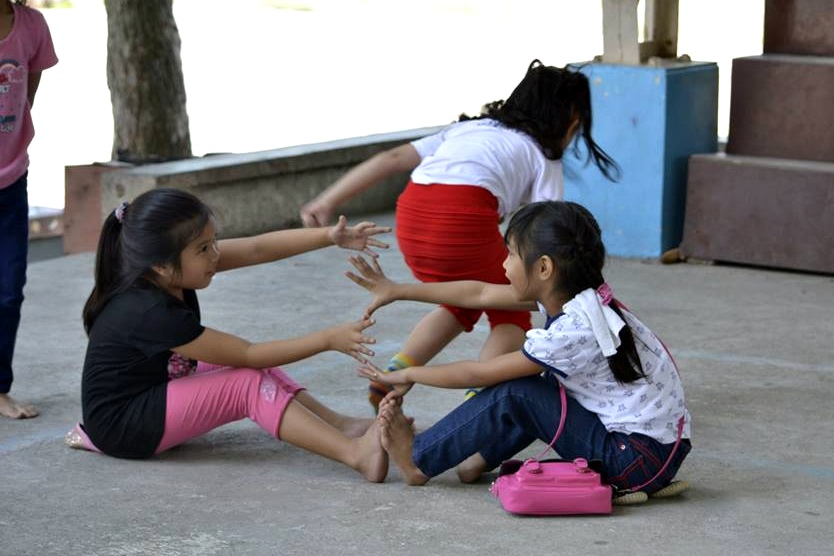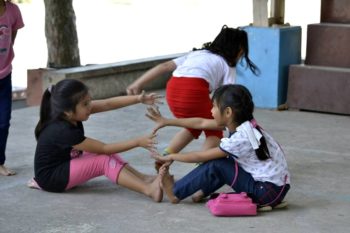 Some of the Media Baby seminar participants from St. Mary’s College of Bansalan took a break and played “Luksong Tinik”, a commonly played game using just the hands and feet.
Photo: Al Divinagracia
Some of the Media Baby seminar participants from St. Mary’s College of Bansalan took a break and played “Luksong Tinik”, a commonly played game using just the hands and feet.
Photo: Al Divinagracia
When Technology Befriends the Filipino Youth

Some of the Media Baby seminar participants from St. Mary’s College of Bansalan took a break and played “Luksong Tinik”, a commonly played game using just the hands and feet.
Photo: Al Divinagracia
Kids spend a lot of waking hours indulging with the gadgets even in front of parents who are supposed to have watchful eyes. From early morning to the breakfast table up until bedtime they could hardly depart from these tablets. The kids, mostly in their school uniform are now habitués of internet cafes wasting away money, time, and their tender bodies. Later on, they are into aberrations like skipping classes. A white lie comes handy and pretty soon the child graduates into a chronic liar. We are yet to be confronted with statistics on e-game addicts. Likewise, with cybersex and child pornography espoused by despicable guardians. The latest CBCP survey shows that sex issues top the list of youth concerns. All these and many more no longer portend a disturbing future, it is now in our midst as real as night follows day.
Interestingly by the time they are born, these youngsters apparently are “genetically” endowed with a knack to operate these electronics. They are so at home with it. So perplexed are the techno-morons (the senior citizens, retirees and the like) about the second nature familiarity these electronic babies have towards these digital playthings. The extent is getting worse and nastier alerting every child psychologist and guidance counselor. Our children are turning into zombies, unfeeling and unflinching. With so many knowledge and information at their command, they end up challengeless and confused. It is no longer the wonderful brain undergoing nurture; it is now the fingertips that do the walking, talking (and thinking).
The accusation of it being harmful is narrow-minded, if not downright unfair to the brilliant faculty of the geniuses whose creation made astounding difference in our lives. The problem has something to do with the excessive, sick pursuit of certain sectors in our society whose dark objectives result to disastrous proportions. The techno-world compounding by leaps and bounds is acknowledged as the harbinger of the present state-of-the-art convenience and easy life. Modern day prophets herald the feats and the unstoppable forces of change and the state of things to come like the laptop on its way to phase-out, people of the world now has to-each-his-own mobile phones, and netizens are becoming rulers of the modern society.
Does technology advance the plight of the poor who people the world far greater in number than the strong, the rich, and the influential who throw their weights around in control of the world’s economy? In its present capacity, technology generally does not reduce poverty. But technology can and will upgrade the status of the poor if humankind will use the tools properly and morally.
We surely cannot bring back the postcard beauty and splendor of a nearby flowing river in all its freshness and simplicity.
Pope Francis in his papal visit conveyed to us Filipinos that we are a glorious children under God’s fold in this part of the world. We despaired with him at the growing percentage of decrease among church-goers. He lost no time zooming into the efficacy of the family as the cradle and bedrock of the youth. Religious upbringing must be planted on young people as early as their babyhood.
In compliment to the youth, we recall one notable event which stood tribute to the impact of their presence and the celebration of the role they have played. It happened in Rio de Janeiro, Brazil, touted as a sin city of the world where Copacabana Beach is known as a display center of flesh and artful debauchery for the eyes. More than 3 million youths from all over the world transformed the place into a spiritual assemblage. That was in 2013 when the World Youth Day, which usually commands huge global attendance, gathered the young people in prayer and religious activities. Consider with joy and pride what the Filipino youths and the Philippines have achieved when we took our turn to stage the World Youth Day in Manila in 1995. It not only attracted a mammoth crowd, it registered in the Guinness World Records the unprecedented 5 million participants, the highest ever in attendance of delegates from all corners of the globe.
The solution has long been with us all along. We just have to hang on it, empower it and revere it more than ever. This force, an omnipresent institution familiar to you and me is known as Family Life. (Vic Baldevia)


No Comments